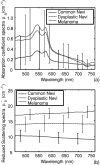In-vivo characterization of optical properties of pigmented skin lesions including melanoma using oblique incidence diffuse reflectance spectrometry
- PMID: 21361657
- PMCID: PMC3061328
- DOI: 10.1117/1.3536509
In-vivo characterization of optical properties of pigmented skin lesions including melanoma using oblique incidence diffuse reflectance spectrometry
Abstract
In this letter, we report the first use of oblique incidence diffuse reflectance spectrometry to conduct in-vivo measurements of optical properties of three different types of pigmented skin lesions, including melanoma, dysplastic, and common nevi. Both absorption and reduced scattering coefficient spectra were estimated from the spatially resolved diffuse reflectance within the wavelength range of 455-765 nm for 144 pigmented skin lesions including 16 melanomas. The absorption and reduced scattering spectra were found to change with the malignancy of the skin lesions, which were generally higher for the malignant cases than the benign ones. Based on the measurement results, the physiological origin leading to the change of the absorption and scattering properties is also discussed.
Figures



Similar articles
-
Toward the discrimination of early melanoma from common and dysplastic nevus using fiber optic diffuse reflectance spectroscopy.J Biomed Opt. 2005 Nov-Dec;10(6):064020. doi: 10.1117/1.2135799. J Biomed Opt. 2005. PMID: 16409085
-
Melanin absorption spectroscopy: new method for noninvasive skin investigation and melanoma detection.J Biomed Opt. 2008 Jan-Feb;13(1):014017. doi: 10.1117/1.2844710. J Biomed Opt. 2008. PMID: 18315375
-
In vivo diagnosis of melanoma and nonmelanoma skin cancer using oblique incidence diffuse reflectance spectrometry.Cancer Res. 2012 Jun 1;72(11):2738-45. doi: 10.1158/0008-5472.CAN-11-4027. Epub 2012 Apr 5. Cancer Res. 2012. PMID: 22491533 Free PMC article.
-
The clinical spectrum of pigmented lesions.Clin Plast Surg. 2000 Jul;27(3):391-408, viii. Clin Plast Surg. 2000. PMID: 10941560 Review.
-
Malignant melanoma: differential diagnosis of pigmented lesions.J Fla Med Assoc. 1997 Mar;84(3):166-74. J Fla Med Assoc. 1997. PMID: 9143168 Review.
Cited by
-
Remote photoacoustic sensing using speckle-analysis.Sci Rep. 2019 Jan 31;9(1):1057. doi: 10.1038/s41598-018-38446-x. Sci Rep. 2019. PMID: 30705342 Free PMC article.
-
Concurrent Reflectance Confocal Microscopy and Laser Doppler Flowmetry to Improve Skin Cancer Imaging: A Monte Carlo Model and Experimental Validation.Sensors (Basel). 2016 Sep 1;16(9):1411. doi: 10.3390/s16091411. Sensors (Basel). 2016. PMID: 27598157 Free PMC article.
-
Clinical evaluation of melanomas and common nevi by spectral imaging.Biomed Opt Express. 2012 Mar 1;3(3):467-72. doi: 10.1364/BOE.3.000467. Epub 2012 Feb 9. Biomed Opt Express. 2012. PMID: 22435095 Free PMC article.
-
Ultrasound-assisted photothermal therapy and real-time treatment monitoring.Biomed Opt Express. 2018 Aug 27;9(9):4472-4480. doi: 10.1364/BOE.9.004472. eCollection 2018 Sep 1. Biomed Opt Express. 2018. PMID: 30615724 Free PMC article.
-
In vivo two-dimensional quantitative imaging of skin and cutaneous microcirculation with perturbative spatial frequency domain imaging (p-SFDI).Biomed Opt Express. 2021 Sep 9;12(10):6143-6156. doi: 10.1364/BOE.428243. eCollection 2021 Oct 1. Biomed Opt Express. 2021. PMID: 34745727 Free PMC article.
References
-
- American Cancer Society, Cancer Facts & Figures 2009, http://www.cancer.org.
Publication types
MeSH terms
Grants and funding
LinkOut - more resources
Full Text Sources
Other Literature Sources
Medical

